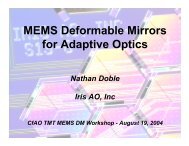PSF reconstruction for Keck AO - Laboratory for Adaptive Optics
PSF reconstruction for Keck AO - Laboratory for Adaptive Optics
PSF reconstruction for Keck AO - Laboratory for Adaptive Optics
Create successful ePaper yourself
Turn your PDF publications into a flip-book with our unique Google optimized e-Paper software.
6 NULL-MODE TILT ANISOPLANATISM 416.2.1 Geometric errorThe specific geometry of the LGS, NGS, turbulence and DM layers set a fundamental limit on the per<strong>for</strong>mance ineach case, based solely on the existence of tomographic null-modes that remain undetected and uncorrected, and thespecific estimator E used. Combining equations (209)-(211) we obtainε i =(P ai − P mi EG a )a − P mi ETn = Q i a − R i n, (212)where I defined the operator Q i = P ai − P mi EG a and R i = P mi ET. The variance of the residual phase error is thenσi 2 = 〈ϕ T ε ϕ ε 〉 =Tr [ 〈ϕ ε ϕ T ε 〉 ] =Tr [ Z〈ε i ε T i 〉Z T ] (213)= Tr [ ZQ i 〈aa T 〉Q T ] i ZT +Tr [ ZR i 〈nn T 〉Ri T ] ZT (214)= Tr ( Q i C aa Q T ) (i +Tr Ri C nn RiT ), (215)where Tr() denotes the matrix trace operation, and we exploited the invariance of the trace under a similaritytrans<strong>for</strong>m Tr(BAB −1 ) = Tr(A), since Z T = Z −1 by orthogonality of the Zernike modes. C aa = 〈aa T 〉 and C nn =〈nn T 〉 are the covariance matrices of Zernike coefficients and WFS noise respectively. C aa can be computed <strong>for</strong>Kolmogorov (Noll, 1976; Wang & Markey 1978)[28, 43] or von Karman (Winker, 1991)[44] statistics. For low-ordermodes and a large aperture, von Karman statistics should be used. The QC aa Q T term is essentially the same as whatis computed by Clare 2006[8]. The noise covariance was modeled here from simple <strong>for</strong>mulas of the standard deviationof the (one-axis) angular position measurement in a Shack-Hartmann type sub-aperture, cf. Eqns. 5.13-5.17 in Hardy1998[23]:σ 2 = 8 θπ SNR , (216)n photSNR = √nphot + N pix (n bg + e 2 ) . (217)In this geometric calculation it does not make much sense to actually include the noise term, since we can drive itto zero without penalty by turning down the frame rate indefinitely in order to get a high SNR. In a real system,this strategy would be penalized by an increasing servo-lag error, which is why we must include the control loopdynamics next.6.2.2 Open loop varianceBecause the analysis becomes complicated in the general case, I will start with a few special cases where we caneasily find exact analytical solutions. First consider the case of an open loop <strong>AO</strong> system with a single WFS framerate and control bandwidth ω s =1/t s ,wheret s is the integration time of the WFS. Referring to Fig. 12, we find themodified spatial-temporal relationship after applying the temporal Fourier trans<strong>for</strong>m to the quantities:and˜α(ω) =C(ω)D(ω)E[S(ω)G a a(ω)+T ñ(ω)], (218)˜ε i (ω) = P ai ã(ω) − P mi ˜α(ω) (219)= [P ai − P mi C(ω)D(ω)ES(ω)G a ] ã(ω) − P mi C(ω)D(ω)ET ñ(ω)} {{ } } {{ }(220)Q i(ω)R i(ω)= Q i (ω)ã(ω) − R i (ω)ñ(ω), (221)where the quantities Q and R were redefined to include the current temporal filter definitions. The residual phasevariance may be computed as be<strong>for</strong>e, with the added operation of integrating over temporal frequencies, that is:∫]σi 2 = dω Tr[〈ε i (ω)ε † i (ω)〉 (222)[∫] [∫]= Tr dω Q i (ω)〈ã(ω)ã † (ω)〉Q † i (ω) +Tr dω R i (ω)〈ñ(ω)ñ † (ω)〉R † i (ω) , (223)



